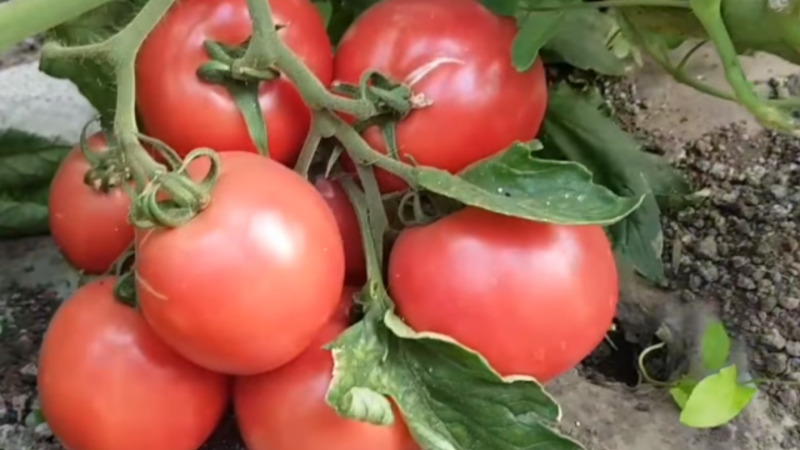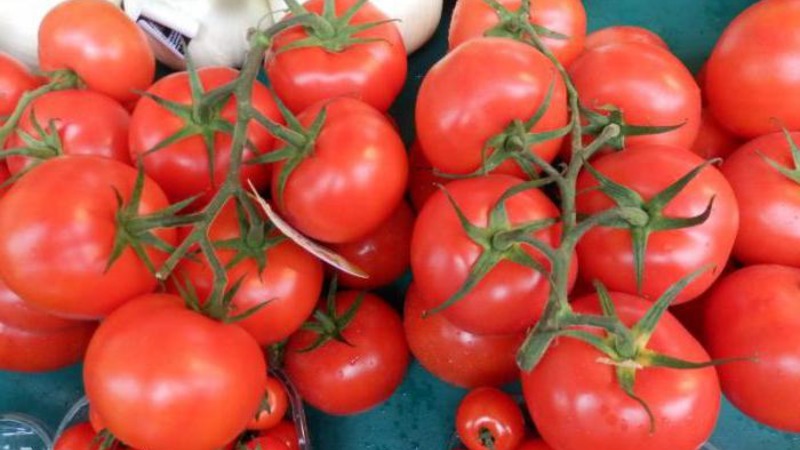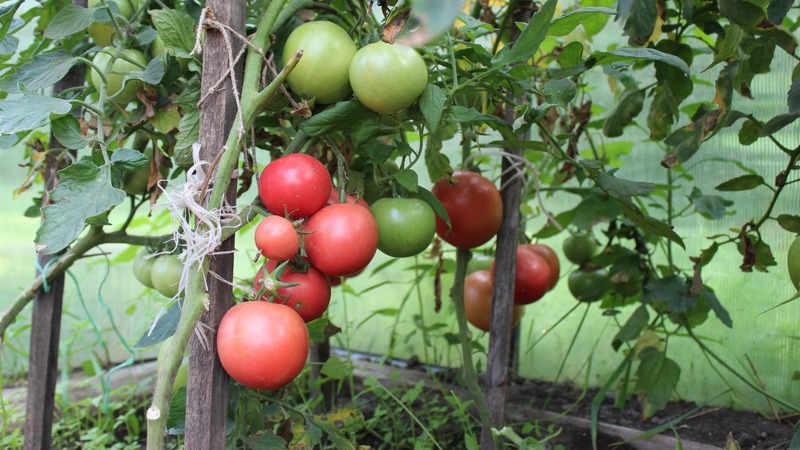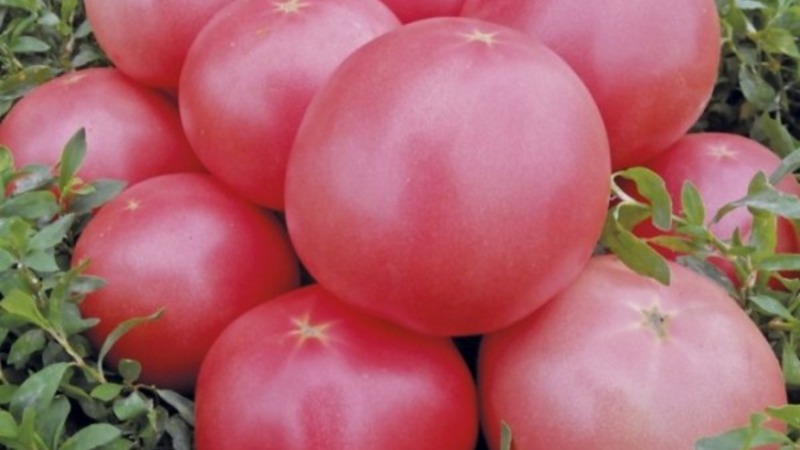Early ripe, undersized, pink tomato variety "Pink bush f1"
Tomato Pink Bush f1 (Pink Bush) is a real find for connoisseurs of pink tomatoes. This variety can boast not only rich sweet taste of fruits, but also increased immunity to diseases, unpretentious care and adaptation to hot climates. According to scientists, the use of pink tomatoes strengthens the immune system and suppresses depressive conditions.
The fruits are characterized by a high content of vitamins, carotene, lycopene and selenium, which is popularly called the hormone of happiness. Therefore, we invite everyone who wants to cheer up to get acquainted with the original Pink Bush tomatoes, which came to us from the land of the Rising Sun.
The content of the article
Characteristics and description of the variety
The creator of the variety is considered to be the Japanese company Sakata.
Bush determinant, undersized, self-pollinated, up to 70 cm high. In the greenhouse it reaches 1.5 m.
reference... Determinant type means limiting the growth of your own flower brush. The shoot of such tomatoes grows until a fruiting ovary appears at the top.
The plant is densely leafy, the leaves are medium-sized. The stem is strong, withstands the weight of the fruit.
An early ripe hybrid - 90-100 days pass from the moment the first shoots appear to full ripening. Recommended for cultivation in open ground and greenhouse conditions.
The culture has an innate immunity against the main diseases of the nightshade family. Resistant to verticillium, cladosporium blight, fusarium wilt, apical rot. It tolerates heat well for a long time. With sharp fluctuations in humidity, the buds do not crumble.
The yield is high. The bush is strewn with fruits. From 1 plant, up to 2 kg of fruits are harvested, provided that 4-6 seedlings are planted per 1 sq. m.
Below is a photo of a Pink Bush tomato bush.

Plants do not need binding and pinching.
Fruits are medium-sized, symmetrical, rounded. The color is bright pink, crimson. The skin is smooth. Seed chambers 4-6. The fruit does not crack. The pulp is juicy, dense. The taste is excellent with a clear sense of sugariness.
In the photo - tomato variety Pink f1.

The species belongs to salad, so tomatoes are ideal for fresh consumption. They are used extremely rarely for pickles and marinades, since the taste is not preserved during heat treatment.
Tomatoes are stored for a long time and can withstand long-term transportation at any distance.
reference... Raspberry-colored tomatoes are superior to red ones in selenium content. Selenium has a positive effect on immunity, improves mental performance and helps to cope with depression.
How to grow seedlings
Sowing begins 35-45 days before planting seedlings in open ground. The grain does not need to be processed and disinfected, the manufacturer took care of everything himself.
It is advisable to prepare the soil mixture in the fall. A little peat, humus and woody are added to the garden soil ash... All components are thoroughly mixed. To destroy pathogenic microflora, the prepared mixture is disinfected with hot a solution of dark-colored potassium permanganate.
reference... Wood ash is not only a source of potassium, but also a preventive measure against fungal diseases.
Sown in a common wooden box, in individual peat pots or plastic glasses. Before sowing, the soil is slightly moistened and compacted. The grains are carefully laid out on the soil surface at a distance of 3-4 cm from each other and sprinkled with a layer of earth of 1 cm.
Crops are watered with warm water and covered with foil or glass to create a greenhouse effect. Before germination, the seed does not need lighting, only light moisture is important for it. The containers are left in a room where the air temperature is at least 24 ° C.
Seedlings appear in 4-5 days. At this moment, the containers are transferred to a well-lit place, where the air temperature during the day is not more than 16 ° C, and at night - 12-13 ° C. This technique helps to harden young seedlings. In this mode, the seedlings are kept for 1 week, and then the temperature is raised to 21 ° C.
The optimal daylight hours are at least 10 hours. With a lack of natural light, additional illumination is provided by fluorescent lamps.
When 2 true leaves appear, a pick is made. During the pick, the sprouts are seated in separate containers, but it is not necessary to put the individual containers too tightly. The seedlings will shade each other and stretch up towards the light. This can lead to improper formation of the stem, it will become thin and long and subsequently will not withstand the mass of fruits.
Water the seedlings as the top layer of the soil dries up with heated and settled water with the addition of a small amount of citric acid to soften.
reference... When growing seedlings, remember that three factors are most important for her: humidity level, temperature regime and lighting.
A month later, the seedlings are hardened. Begin with 2-3 hours of seedlings being outdoors in the shade. Gradually, the time is increased to 8 hours. In the last 2 days before planting in the ground, the seedlings are left outside overnight.
How to grow tomatoes
After 35-45 days, the seedlings are ready for transplanting into the ground. At this time, the bushes already have 7-9 true leaves and 1-2 ovaries of fruit brushes.
reference... Transplant seedlings on time, otherwise there will be no proper harvest.
The hybrid will not take root in acidic soil, so checking the acid-base balance is mandatory. This is done with the help of litmus paper: 20 g of soil is mixed with 50 ml of distilled water and shaken well. A litmus indicator is dipped into the resulting suspension. If the paper has not changed color, the acidity is normal. If it turns red, the acidity is exceeded.
Dolomite flour or slaked lime neutralizes acidity. Before planting, the soil is dug up and nitrogen-containing and mineral fertilizers are introduced into it.
Tomatoes cannot be planted in the land where crops from the Solanaceae family previously grew, since they draw the same nutrients from the ground. In addition, solanaceous pathogens may survive there. Good predecessors are carrots, cabbage, herbs, legumes. The same crops are also suitable as neighbors for tomato.
Planting pattern: 45-50 cm - distance between plants, 40 cm - between rows. Seated in a checkerboard pattern, 4-6 seedlings per 1 sq. m.
After transplanting, the seedlings are watered, loosened and left unattended for 10 days.
Proper watering especially important for the growth and development of culture. To keep the beds moist, mulch... Watered with exceptionally warm, settled water under the root. The culture responds well to drip irrigation.
There is no need to overmoisten the soil, twice a week is quite enough, with the exception of hot days, when the number of irrigations is increased to 3-4 times a week, depending on the ambient temperature. Excessive moisture negatively affects the taste of the fruit, they become watery.
The first top dressing carried out at the beginning of flowering, then - during the formation of the ovary and during the fruiting period. Fertilizers for the hybrid are complex mineral or organic fertilizers: "Master", "Clean sheet". They contain all the elements necessary for the full growth and development of plants.
The tomato does not need pinching and binding garter, but some gardeners install wooden garter stakes next to the plants so that the branches do not break from their own weight.

Diseases and pests
Pink Bush tomatoes have a truly high disease resistance. For this reason, it is quite possible to get by with simple preventive measures throughout the entire growing season. Prevention consists in regular weeding and loosening of the soil. Also, compliance with the rules of crop rotation and agricultural technology increases the immunity of a vegetable crop.
Whitefly and slugs are dangerous pests. The slugs are collected by hand and sprinkled with tobacco dust or ground red pepper on the beds. Tobacco crumbs, onion and garlic arrows, or any pungent-smelling plants save you from whitefly.
The nuances of growing in protected and unprotected ground
The variety is recommended for cultivation both in greenhouse conditions and in open beds. A high rate of fruiting when planted in protected soil is obtained in the Urals, Siberia, the Far East and the European part of Russia. The ideal climate for a hybrid is considered to be the weather conditions of the Black Sea and Crimea.
The height of the determinant bush of this species depends on the growing conditions. In a greenhouse, growth reaches 1.7 m, while in unprotected soil, the height of the bushes is no more than 70 cm.
Due to their large growth, greenhouse plants need a garter, although many also tie up street bushes, since the culture is distinguished by a large number of set fruits on one brush. Tying plants in the open field is usually required during mass ripening, since vegetables ripen together and noticeably make the fruit-bearing branches heavier, as can be seen in the photo.

To increase the number of ovaries, flowering bushes are sprayed with a weak boric acid solution (1 g per 1 liter).
In a greenhouse, it is important to control the humidity level to avoid the growth of fungal spores. For this, closed structures are regularly ventilated. But you should not create drafts, the tomato does not like them.
In warm weather, experienced gardeners manage to harvest a second crop. This is possible in greenhouse conditions. After the main harvest, the old branches are removed, and new fruits are tied on the remaining stepsons. But compared to the previous ones, these tomatoes are significantly inferior in weight.
Harvesting and application of the crop
Fruit ripening begins in July and, thanks to extended fruiting, stretches for 2-3 weeks. Vegetables ripen together, with whole brushes.
The variety is salad, therefore, first of all, it is consumed fresh. Fresh salads are especially good, but tomatoes are also used in baking, in vegetable and first courses.
For pickles and marinades, they are used extremely rarely, since the taste is not preserved during heat treatment. But the tomato paste turns out to be first-class, only paler than usual. Small tomatoes are used for whole fruit canning and do not lose their flavor when dried.
Vegetables are subject to long storage and are well transported over any distance. They have an attractive presentation that goes well with excellent taste. Thanks to this, the variety does not stale on the shelves, increasing consumer demand every year. Many farmers breed it for subsequent sale in the markets.

Advantages and disadvantages
Let's list the positive properties due to which the culture occupies a leading position in the markets of many countries:
- unpretentious care;
- disease resistance;
- high rate of fruiting;
- adaptation to hot climate;
- survival rate in all regions;
- does not require an obligatory garter;
- does not require pinning;
- decorativeness of bushes;
- excellent taste and benefits of fruits;
- presentable appearance;
- fruits do not crack;
- long storage and long-term transportation;
- high consumer demand;
- suitable for cultivation for sale.
Negative properties include:
- high price of seeds (do not forget that the variety is hybrid, and you will not be able to select grains for the next planting yourself);
- more complex care for seedlings, unlike other varieties;
- the influence of high humidity on the taste of vegetables.
Farmers reviews
Reviews about the variety are very eloquent and unanimous that it simply cannot be found better and tastier than tomatoes. Here are some of the opinions of fans of this hybrid:
Evgeniy, Rostov region:“Gorgeous hybrid. Raspberry color, medium size. Goes for everything: salad, jar, tomato juice. I put it in a greenhouse. There are always a lot of vegetables. I take only from the manufacturer. I will not trade for anything. "
Anton, Belgorod region:“I grow Pink Bush in a polycarbonate greenhouse. Amicable ripening, prominent fruits. Early tomatoes always sell well, and this hybrid has the advantage of excellent taste and great appearance. Yes, and delicious. I advise you to plant it.
Conclusion
According to the Japanese proverb, when the seller's compliments are clever, the product is bad. The Japanese company Sakata has proven the opposite with its unusual hybrid. Seeds varieties, distinguished by its resistance to diseases, high yields, unpretentious care and good adaptation in all regions, diverge to all parts of the world, despite its high cost.
Ornamental bushes adorn numerous garden beds not only in Russia. And ripe vegetables in the markets are snapped up at an amazing speed, because the goods offered are really of excellent quality.